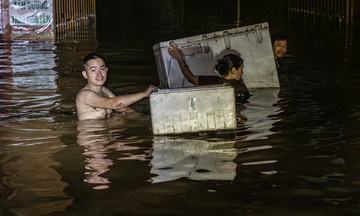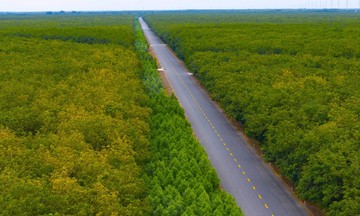Late in the afternoon of 25/8, 55-year-old Tran Dinh Quang waded through knee-deep mud in his 2,500 m2 melon farm in Binh Nguyen village, Loc Ha commune. Buried beneath the mud were his crushed and drowned melon plants.
Quang's melon farm sits amidst vibrant green rice paddies. Had the typhoon not struck, in just over 10 days, the rice would have been ready to harvest, coinciding with the second melon harvest of the year. Now, the farm is in ruins. The metal frame is twisted, and large sections of netting are torn.
"'>
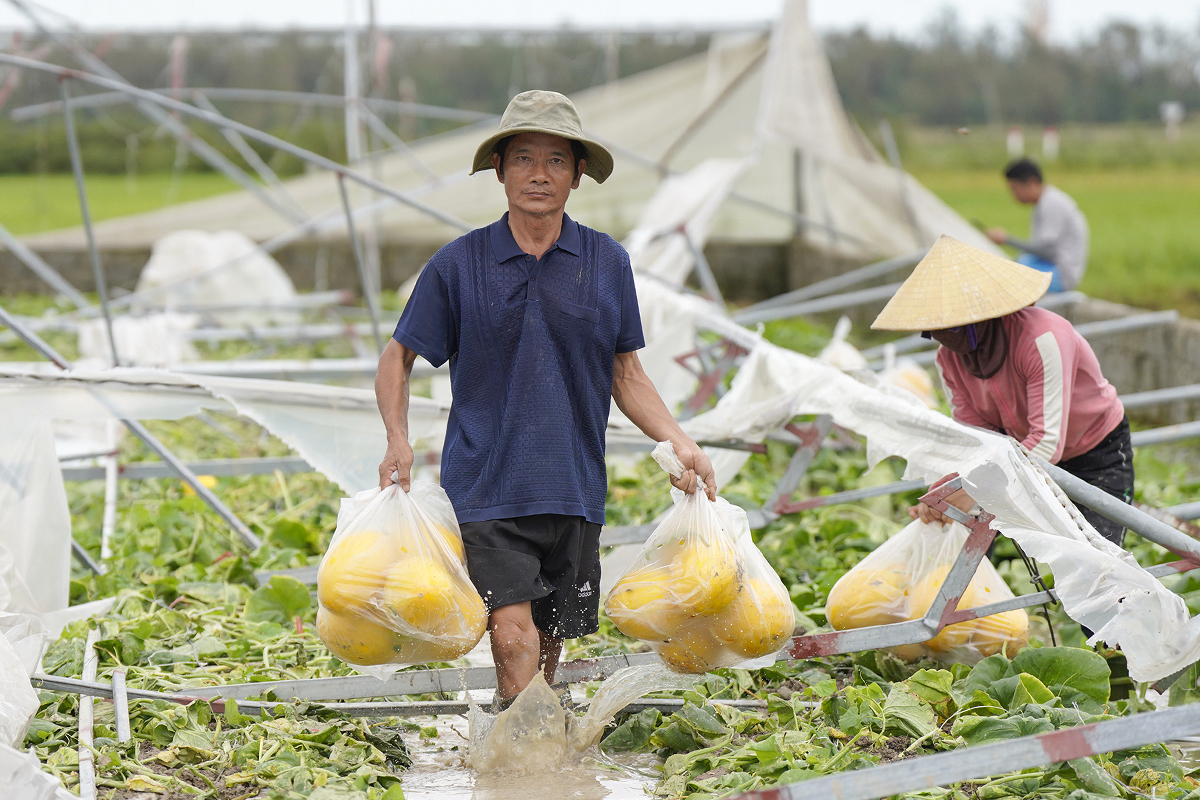 |
Quang previously cultivated rice and other crops. Three years ago, he learned about the high-yield potential of melon farming. He sought guidance from experienced growers and secured a loan of one billion dong, using his land title as collateral, to invest in greenhouses, irrigation systems, seeds, substrates, and fertilizers. His first melon harvest yielded nearly 200 million dong, putting him on track to recoup his investment within five years.
News of Typhoon Kajiki's approach filled Quang with unease. His farm, situated in the middle of an open field just 3 km from the coast, was exposed to winds from all directions, with no way to reinforce it. On the afternoon of 25/8, the typhoon made landfall in Ha Tinh. The initial gusts rocked the greenhouse but it held firm.
"Around 4 pm, the wind suddenly shifted, blowing inland from the sea. The greenhouse buckled and collapsed," Quang recounted. His family watched in stunned silence from their home as their farm was destroyed.
"The ripe melons, even if harvested a bit early, could still have been salvaged. But the real devastation is the 1,500 m2 of melons that were a meter tall. I planned to introduce bees for pollination next week to ensure a continuous harvest. Now, it’s all gone," Quang said, turning away to hide his tears.
Quang estimates his losses at one billion dong for the greenhouse and 200 million dong for the damaged melons, seedlings, substrates, and fertilizers. "I’ll try to salvage the undamaged metal frames to rebuild a smaller greenhouse. Natural disasters are unavoidable. I have to get back on my feet," he said resolutely, his voice faltering as he wondered how he would find the funds.
On the evening of 25/8, as Typhoon Kajiki churned through the waters off north-central Vietnam, strong winds battered Cua Lo ward in Nghe An province, ripping down signs, uprooting trees, and shattering decorative lights.
"'>
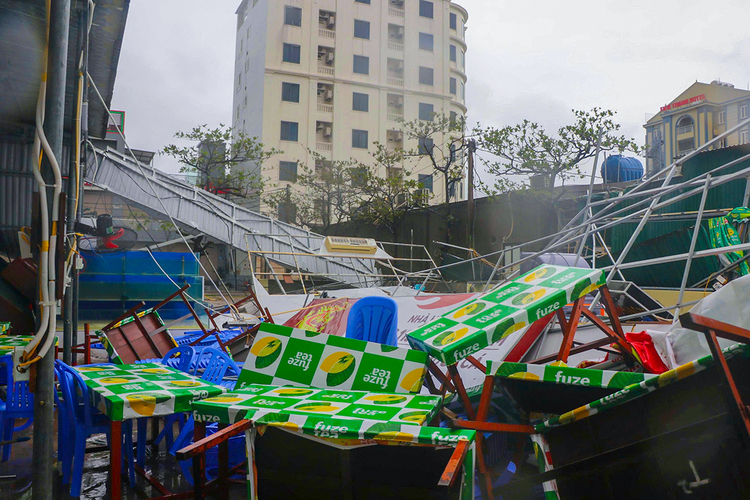 |
The following morning, Vo Van Nam, the owner of a seafood restaurant on Binh Minh street, stared in disbelief at his ruined business. Half of his 200 m2 restaurant had collapsed. Tables, chairs, refrigerators, electronic equipment, and kitchenware lay scattered beneath a tangle of steel, corrugated iron, electrical wires, and signage.
Nam estimates his losses at 800 million dong, a significant sum for a business reliant on Cua Lo’s short 3-4 month tourist season. Before the typhoon, he and his staff managed to move some seafood and supplies to safety. However, the remaining equipment, including freezers, grills, lighting, and other items, was completely destroyed.
"Years of hard work and savings to expand my restaurant, and now it’s all gone," Nam lamented. For the past two days, his family has been frantically clearing the debris, salvaging anything that can be repaired.
Typhoon Kajiki struck just days before the September 2 holiday, the final peak of the beach tourism season. For Nam and other seafood restaurant owners in Cua Lo, this period was crucial for boosting revenue before the lean winter months.
The typhoon’s devastation has shattered those hopes. Rebuilding will take several weeks and require hundreds of millions of dong. Given the widespread damage caused by the typhoon, borrowing from family and friends is difficult, so Nam is considering a bank loan.
About 60 km from Cua Lo, An Chau commune also suffered heavy losses. Vo The Quang, 56, sat dejectedly by the shore, explaining how the storm surge had swept his 25,000 nearly market-ready shrimp out to sea.
"'>
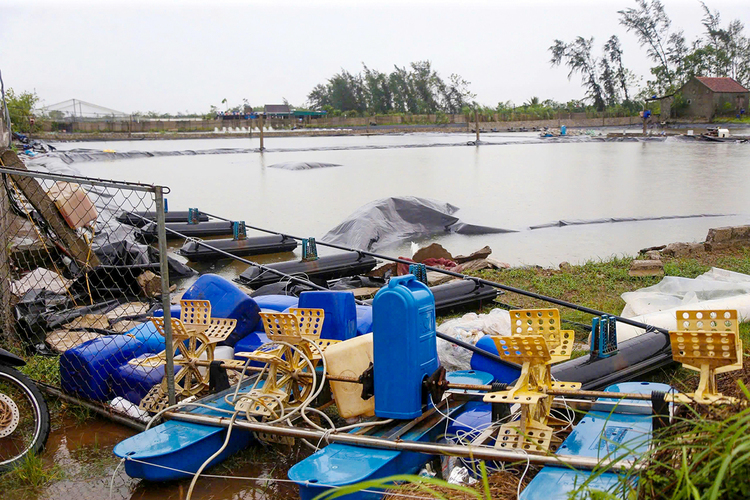 |
On the afternoon of 25/8, upon hearing of the approaching typhoon, Quang and other shrimp farm owners rushed to reinforce their embankments and move pumps and feed to safety. But by evening, the relentless wind and rain brought a powerful surge. From 8 pm, seawater overflowed the dikes and flooded the shrimp ponds. By midnight, when the waters receded, his two 3,000 m2 ponds were filled with mud, dead shrimp, and debris. "It’s a total loss, hundreds of millions of dong," Quang sighed.
Quang plans to hire workers to dredge the ponds and restore the environment as soon as the water recedes, so he can stock new shrimp. "Even though I'm already in debt, I have to borrow more to start over. If I give up this work, how will I support my family?" he said, gazing helplessly out at the sea.
Typhoon Kajiki made landfall in Thanh Hoa and Ha Tinh provinces on the afternoon of 25/8, packing winds of level 10-11, gusting to level 13. It raged for 10 hours, bringing heavy rain from north-central Vietnam to several northern provinces. The disaster resulted in three deaths, five missing persons, and 47 injuries. 17 houses collapsed, over 30,800 houses had their roofs blown off, nearly 4,000 houses were flooded, and hundreds of schools, health facilities, and cultural buildings were damaged.
92,200 ha of rice, 10,800 ha of other crops, 9,700 ha of fruit trees, and nearly 10,000 ha of forest were damaged; 49,000 livestock and poultry perished. The typhoon also sank 102 boats, caused landslides along over 7,000 m of riverbanks and canals, and disrupted 500 kV and 220 kV power lines. Over 753,000 customers, mainly in Nghe An, are still without power.
Nguyen Dong - Duc Hung




